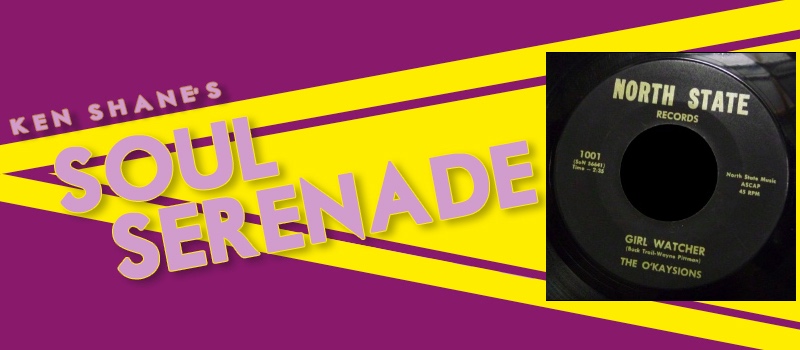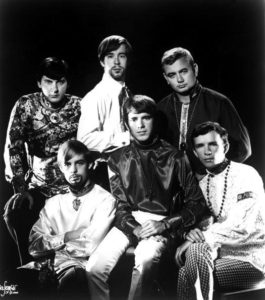 They called themselves the Kays when they first got together in Kenly, North Carolina. The year was 1959, and the original lineup included guitarist Wayne Pittman, trumpet player Eddie Dement, sax player Gerald Toler, bassist Jimmy Hinnant, drummer Steve Watson, and vocalist/organ player Donnie Weaver, who was only 12 years-old at the time.
They called themselves the Kays when they first got together in Kenly, North Carolina. The year was 1959, and the original lineup included guitarist Wayne Pittman, trumpet player Eddie Dement, sax player Gerald Toler, bassist Jimmy Hinnant, drummer Steve Watson, and vocalist/organ player Donnie Weaver, who was only 12 years-old at the time.
It took nearly 10 years, but on February 8, 1968, the O’Kaysions found themselves in what was described as a “broom closet studio” called Sound Studio in Greenville, NC. That day they recorded a song that Pittman had written called “Girl Watcher.” The record featured the now 22 year-old Weaver on the lead vocal. Weaver was also responsible for the idea of re-christening the band as the O’Kaysions.
Pittman wrote the melody and lyrics to “Girl Watcher” after his bandmates suggested that he do so, given his penchant for staring at girls on the beach. Weaver chipped in the “um, um, um,” and they were all set. The single was released on tiny North State Records, and the label owner Rick Trail was given a writing credit, although it was clear that the song was all Pittman’s.
The town of Burlington, NC is nowhere near the beach, but that’s where the record first broke out, after being given heavy airplay by local station WBAG. The record came to the attention of Bill Griffin, who owned a company called Game Artists, and Ken Adkins, who worked for Griffin’s company. They, together with Manly May, began to shop the record to New York labels. It landed at ABC Paramount, which rush released the single with no changes.
It turned out to be the right strategy as “Girl Watcher” soared to #5 on the Billboard Hot 100, and #6 on the R&B chart. The single resided in the Top 10 for nine weeks, and had sold a million copies, and earned a gold record, by the end of 1968. According to Billboard, it was the 45th biggest record of that epochal year in music.

At that point, Watson, Toler, and Dement decided to keep their day jobs, so Weaver, Pittman, and Hinnart needed some new players in order to go on tour. Trumpeter Ron Watson, sax player Jim Spiedel, and drummer Bruce Joyner were added. It was with that lineup that the O’Kaysions entered the studio in the fall of 1968 to record the Girl Watcher album for ABC. The album was recorded in just two days to capitalize on the hit single, and despite some good reviews, it only did moderate business, reaching #49 on the R&B chart, but peaking at #153 on the Pop albums chart.
The O’Kaysions followed-up their hit with the ABC single “Love Machine.” It didn’t do nearly as well as its predecessor, only reaching #76 on the Billboard Hot 100, although it made the Top 50 on the Cashbox chart. It was the last time the band would put a record on the charts.
Management problems began to hinder the O’Kaysions at that point. According to Pittman, the band’s original label, North State, felt it had the right to sign them to a booking agency without the band’s approval. One of those that the band was assigned to was Atlanta promoter Bill Lowery, but when Lowery failed to get the band enough work, they left him and signed with Associated Booking in New York. But Lowery was a powerful man, and Pittman contends that he “put the kiss of death” on the O’Kaysions. Meanwhile, ABC Paramount wasn’t willing to spend much money promoting them.
From that point on, the history of the O’Kaysions involves a number of lineup changes, but the band rolled on … and on. Pittman left, and guitarist Donny Trexler came in, along with drummer Gary Pugh. They went to New York to sing on the band’s new single, a cover of Gene Pitney’s “24 Hours to Tulsa.” I say sing because apparently no member of the O’Kaysions actually played on the record. The single got a good review in Billboard, but failed to chart.
Weaver had his own contract with ABC, and left the band to begin a solo career in August, 1969. Spiedel was drafted that fall, and Turner left at around the same time. What remained of the band, which now featured Trexler on lead vocals, signed with Atlantic Records. At the end of the year, a faulty latch on the band’s truck resulted in the loss of some treasured musical equipment, and it seemed that the end was near for the O’Kaysions.
The band continued to tour regularly, enduring more lineup changes, and eventually released a single for the new Atlantic imprint Cotillion Records in the spring of 1970. “Watch Out Girl” got another rave review in Billboard, and it was widely thought that the single would be the O’Kaysions return to glory. Unfortunately, the single sunk like a stone. Recording began for a new Cotillion album, but it was eventually shelved due to a dispute between the label and the band’s management over, guess what, money.
Trexler left the band in March, 1972, and although they soldiered on for a little while, the writing was on the wall. Weaver’s solo career consisted of just one single, the Jackie Lomax cover “Speak to Me.” He eventually retired and worked as a computer consultant, but came back in the early part of the new century. His return included a reunion of the original O’Kaysions lineup at Alabama Theater in Myrtle Beach, South Carolina in late-2003. That night the band performed their hit “Girl Watcher” at the Carolina Beach Music Association Hall of Fame Awards. The O’Kaysions continue to roll on to this day. The one original member of the band, which is now based in Columbia, SC, is Wayne Pittman.





Comments